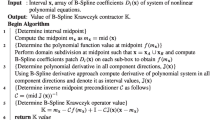Abstract
Convex optimization has emerged as a well-suited tool for passive approximation. Here, it is desired to approximate some pre-defined non-trivial system response over a given finite frequency band by using a passive system. This paper summarizes some explicit results concerning the Hilbert transform of general B-splines of arbitrary order and arbitrary partitions that can be useful with the convex optimization formulation. A numerical example in power engineering is included concerning the identification of some model parameters based on measurements on high-voltage insulation materials.
Access this chapter
Tax calculation will be finalised at checkout
Purchases are for personal use only
Similar content being viewed by others
References
N.I. Akhiezer, The Classical Moment Problem (Oliver and Boyd, Edinburgh, 1965)
F. Alvarez, A. Alegra, J. Colmenero, Relationship between the time-domain Kohlrausch-Williams-Watts and frequency-domain Havriliak-Negami relaxation functions. Phys. Rev. B 44, 7306–7312 (1991)
E.J. Beltrami, M.R. Wohlers, Distributions and the Boundary Values of Analytic Functions (Academic, New York, 1966)
A. Bernland, A. Luger, M. Gustafsson, Sum rules and constraints on passive systems. J. Phys. A Math. Theor. 44(14), 145–205 (2011)
S. Boyd, L. Vandenberghe, Convex Optimization (Cambridge University Press, Cambridge, 2004)
C. de Boor, On calculating with B-splines. J. Approx. Theory 6(1), 50–62 (1972)
U. Gafvert, L. Adeen, M. Tapper, P. Ghasemi, B. Jonsson, Dielectric spectroscopy in time and frequency domain applied to diagnostics of power transformers, in Proceedings of the 6th International Conference on Properties and Applications of Dielectric Materials (Cat. No.00CH36347), vol. 2 (2000), pp. 825–830
F. Gesztesy, E. Tsekanovskii, On matrix-valued Herglotz functions. Math. Nachr. 218(1), 61–138 (2000)
H. Ghorbani, M. Saltzer, F. Abid, H. Edin, Effect of heat-treatment and sample preparation on physical properties of XLPE DC cable insulation material. IEEE Trans. Dielectr. Electr. Insul. 23(5), 2508–2516 (2016)
M. Grant, S. Boyd, CVX: a system for disciplined convex programming, release 2.0, Ⓒ2012 CVX Research, Inc., Austin, TX
M. Gustafsson, D. Sjöberg, Sum rules and physical bounds on passive metamaterials. New J. Phys. 12, 043046 (2010)
M. Gustafsson, D. Sjöberg, Physical bounds and sum rules for high-impedance surfaces. IEEE Trans. Antennas Propag. 59(6), 2196–2204 (2011)
M. Gustafsson, M. Cismasu, S. Nordebo, Absorption efficiency and physical bounds on antennas. Int. J. Antennas Propag. 2010 (Article ID 946746), 1–7 (2010)
S. Havriliak, S. Negami, A complex plane representation of dielectric and mechanical relaxation processes in some polymers. Polymer 8, 161–210 (1967)
Y. Ivanenko, S. Nordebo, Approximation of dielectric spectroscopy data with Herglotz functions on the real line and convex optimization, in 2016 International Conference on Electromagnetics in Advanced Applications (ICEAA), September 2016, pp. 863–866
Y. Ivanenko, M. Gustafsson, B. Jonsson, A. Luger, B. Nilsson, S. Nordebo, J. Toft, Passive approximation and optimization using B-splines (2017). Preprint. ar**v:1711.07937
I.S. Kac, M.G. Krein, R-functions - Analytic functions map** the upper halfplane into itself. Am. Math. Soc. Transl. 103(2), 1–18 (1974)
R. Kress, Linear Integral Equations, 2nd edn. (Springer, Berlin, 1999)
S. Nordebo, M. Gustafsson, B. Nilsson, D. Sjöberg, Optimal realizations of passive structures. IEEE Trans. Antennas Propag. 62(9), 4686–4694 (2014)
S. Nordebo, M. Dalarsson, Y. Ivanenko, D. Sjöberg, R. Bayford, On the physical limitations for radio frequency absorption in gold nanoparticle suspensions. J. Phys. D Appl. Phys. 50(15), 3 (2017)
H.M. Nussenzveig, Causality and Dispersion Relations (Academic, London, 1972)
K.N. Rozanov, Ultimate thickness to bandwidth ratio of radar absorbers. IEEE Trans. Antennas Propag. 48(8), 1230–1234 (2000)
W. Rudin, Real and Complex Analysis (McGraw-Hill, New York, 1987)
B. Simon, Harmonic Analysis. A Comprehensive Course in Analysis, part 3 (American Mathematical Society, Providence, 2015)
C. Sohl, M. Gustafsson, G. Kristensson, Physical limitations on broadband scattering by heterogeneous obstacles. J. Phys. A Math. Theor. 40, 11165–11182 (2007)
I. Vakili, M. Gustafsson, D. Sjöberg, R. Seviour, M. Nilsson, S. Nordebo, Sum rules for parallel-plate waveguides: experimental results and theory. IEEE Trans. Microw. Theory Tech. 62(11), 2574–2582 (2014)
A.H. Zemanian, Distribution Theory and Transform Analysis: An Introduction to Generalized Functions, with Applications (McGraw-Hill, New York, 1965)
Acknowledgements
This work was supported by the Swedish Foundation for Strategic Research (SSF) under the program Applied Mathematics and the project Complex analysis and convex optimization for EM design.
Author information
Authors and Affiliations
Corresponding author
Editor information
Editors and Affiliations
Appendix
Appendix
The discontinuity behavior of linear B-splines N 0,2(x) with knot values N 0,2(x 1)=1 and N 0,2(x 0) = N 0,2(x 2) = 0 is given by
The discontinuity behavior of quadratic B-splines N 0,3(x) with knot values N 0,3(x 1) = (x 1 − x 0)∕(x 2 − x 0), N 0,3(x 2) = (x 3 − x 2)∕(x 3 − x 1), and N 0,3(x 0) = N 0,3(x 3) = 0 is given by
The discontinuity behavior of cubic B-splines N 0,4(x) with knot values
and N 0,4(x 0) = N 0,4(x 4) = 0 is given by
Rights and permissions
Copyright information
© 2019 Springer Nature Switzerland AG
About this paper
Cite this paper
Ivanenko, Y., Nordebo, S. (2019). Passive Approximation with High-Order B-Splines. In: Lindahl, K., Lindström, T., Rodino, L., Toft, J., Wahlberg, P. (eds) Analysis, Probability, Applications, and Computation. Trends in Mathematics(). Birkhäuser, Cham. https://doi.org/10.1007/978-3-030-04459-6_8
Download citation
DOI: https://doi.org/10.1007/978-3-030-04459-6_8
Published:
Publisher Name: Birkhäuser, Cham
Print ISBN: 978-3-030-04458-9
Online ISBN: 978-3-030-04459-6
eBook Packages: Mathematics and StatisticsMathematics and Statistics (R0)



